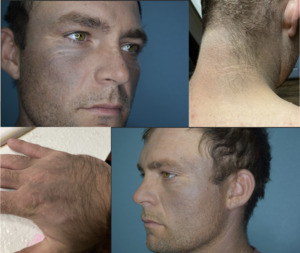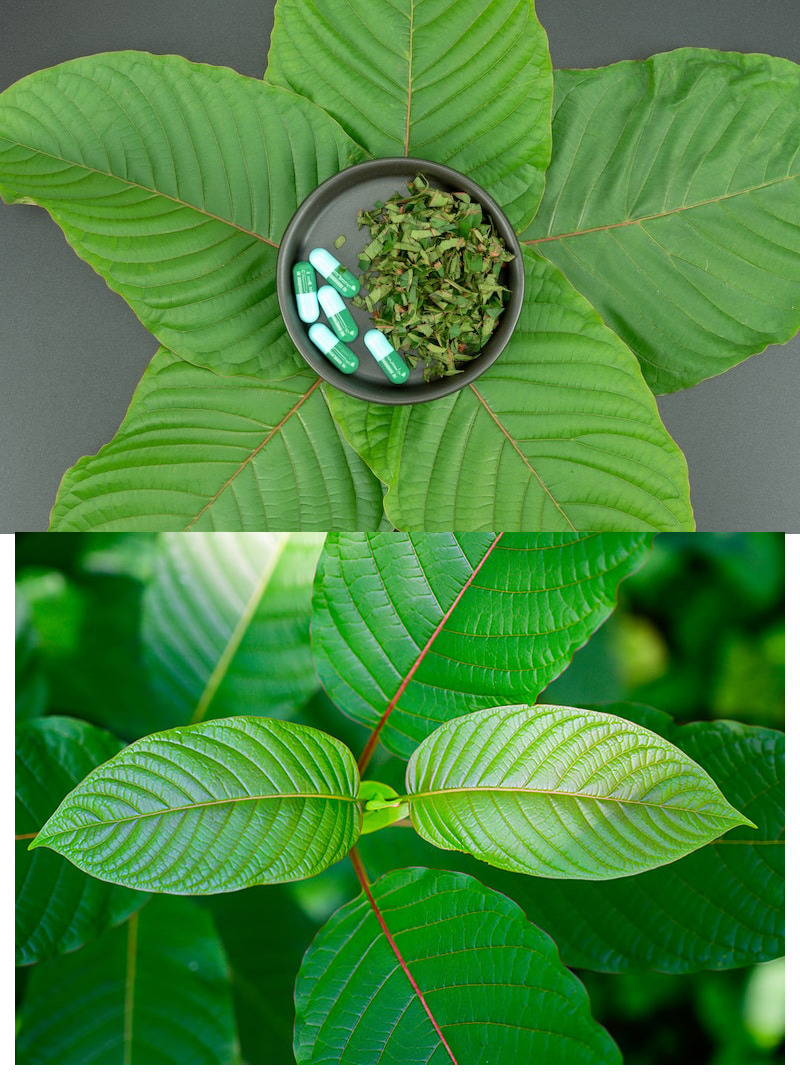Introduction
Kratom, or Mitragyna speciosa, is a plant originating from Southeast Asia. In recent years, kratom has gained popularity due to its ability to induce stimulant-like effects at low doses and opioid-like effects at high doses.1 Kratom leaves may be boiled into a tea, chewed, smoked, or dried, powdered, and/or put into capsules for consumption. Often the herb is used for pain relief following opioid withdrawal, but many use it for its psychoactive effects as well.2 While kratom possesses analgesic properties, it is not regulated by the FDA, and can have a variety of dangerous side effects. Side effects of kratom include tachycardia, drowsiness, vomiting, confusion, hallucinations, respiratory depression, and cardiac arrest.3 Kratom also possesses the potential for addiction and dependency due to its opioid-like properties.4 This case study details an additional side effect of discoloration of the skin in sun-exposed areas when taking kratom in high doses.
Case Report
A 30-year-old Caucasian male with no prior medical history or long-term medication use presented with a dark gray-blue discoloration of the skin. The hyperpigmentation is present in the cheeks of the face, the back of the neck, and the backs of the hands and forearms.
The patient reported taking kratom for five years. This started due to an opioid addiction following a high school injury for which he received opioid pain medications. He developed an opioid use disorder, and eventually decided to replace his pain medications with kratom to ease his pain. The patient reported taking capsules of the herb and would sometimes put the powder directly on his tongue and wash it down with fluids. He took high doses to achieve an opioid-like effect, starting at 8-15 grams a day for the first year. At this dose, he noticed problems with his vision and developed anxiety. For the next 4 years he continued to take 3-7 grams a day. He says he did not see an ophthalmologist for the vision changes, and that once he lowered the dosage, he no longer had any problems with vision. He has not had any issues with vision since then. He did not notice any discoloration of the skin until he was 4.5 years into using kratom. He described a sudden onset and fast progression of darkening in photo-distributed areas (Figure 1). There was no hyperpigmentation on the nails or on any mucosal areas, including the oral cavity. Additionally, there were no pigmentation differences in the sclerae or irises of the eyes. The patient noted that he goes fishing often and was regularly exposed to the sun.
He did not have any other medical conditions and did not take any medications or supplements that cause hyperpigmentation while using kratom. He has not taken minocycline before or any other chronic medications. The patient stopped using kratom in May 2022, but the discoloration remains. It has not regressed in the following 16 months after discontinuing kratom use.
Discussion
Kratom is widely used across the world, and while not regulated in the United States, a number of side effects can ensue from its use. Several case studies detail patients who were taking kratom at high doses, also with chronic sun exposure, who experienced a similar gray-blue hyperpigmentation in the face, back of neck, and backs of hands extending into the arms.7,8 The possibility may happen at lower dosages also, with or without extensive sun exposure. Additionally, kratom users may experience a variety of side effects if taking other medications, as kratom alters the hepatic P450 enzymatic activity and drug metabolism.9 Low doses of kratom result in a stimulant-like effect, whereas high doses of kratom may achieve an opioid-like effect. This is thought to be due to the main alkaloid active ingredients, mitragynine and 7-hydroxymitragynine, which have potent central nervous system (CSN) stimulant and depressive effects via interaction through monoaminergic and mu-opioid receptors.10
In biopsies of similar patients who experienced hyperpigmentation after using kratom, pigmented histiocytes were seen. No excess iron, inflammation, or abnormalities were found.7,8 The exact mechanism by which hyperpigmentation of the skin happens in kratom users is unknown, although it is hypothesized that the increase in dopamine from the herb may cause upregulation of the melanocyte stimulating peptide activity, or that a melanin-drug complex deposition may be at play.7 Additionally, similar presentations of blue-gray hyperpigmentation may be seen in other conditions, some of which involve the same physiological pathways (Table 1).11–14
Whether or not the hyperpigmentation is able to regress is unknown. Treatment options for hyperpigmentation secondary to kratom use include discontinuation of consumption and treatment of the skin with a Q switch laser.15,16 While we have not seen instances of people with blue-gray hyperpigmentation secondary to kratom use treated with a Q switch laser, this method has been successful in removing dark hyperpigmentation secondary to necrobiotic xanthogranuloma and removing blue-gray hyperpigmentation secondary to amiodarone use.15,16
Conclusion
Kratom use is unregulated, and patients should be cautious if using the herb. In some individuals, sun exposed areas of the skin may become hyperpigmented with a distinct dark gray-blue color. This appears to favor the face, back of neck, hands, and backs of arms. Kratom may also cause a variety of other side effects that may affect the cardiovascular, respiratory, and nervous systems. The mechanism behind why this discoloration happens is not well understood and should be further explored in future studies. Kratom-induced hyperpigmentation should be considered in differential diagnoses for patients with similar presentations of gray-blue discoloration in photo distributed areas.
Funding sources
No funding was received for this case study.
Conflicts of interest
No conflicts of interest are present for any of the authors of this case study.



